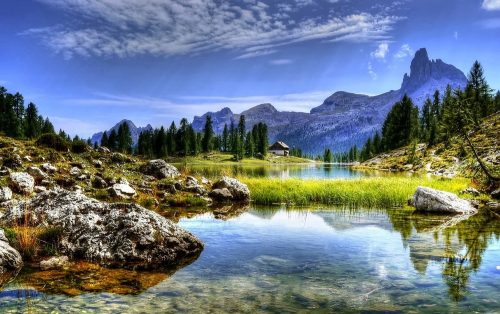As a photographer, you probably cannot drive through a scenic location without stopping to get some amazing shots along the way. Those who love the stillness and serenity of a beautiful landscape can spend hours at a location or even days, trying to look for compositions from various vantage points and under different lighting conditions to get a striking photograph.
More often, when you quickly take a photograph, you end up coming home only to see some flat images with no life or feeling that you witnessed in reality. In order to make beautiful landscapes, there are many factors that need to be taken into account, but in today’s post, we will focus on three very important composition rules that will help you get a perfect shot.
Note: As with any “rule” in photography, it's often best to know them and then use them as a guideline more than a rule. 😉
1. Rule of thirds: The most important rule for landscape photography is the rule of thirds. In this composition, divide your frame into 9 equal parts using 2 vertical and two horizontal lines. Position the important elements of the scene along these lines or the intersection of these lines to create a visual balance in your image and to make for interesting compositions.
Place the horizon on the lower one-third or upper one-third of the image, unless you are trying to capture symmetry and/or reflection.

Image from Pexels by Ales Krivec

Image by Tadrart01.JPG: Pir6mon derivative work: Teeks99, [CC BY-SA 3.0], via Wikimedia Commons
Leading lines: Our eyes are naturally drawn to lines, patterns, and textures. Lines lead a viewer’s eyes naturally through the image to the main focal point. Lines could include paths, trails, roads, rivers or even lines in fields. Try to creatively include these lines in your landscapes to create a powerful composition.

Image on Pexels by Stories of Kabeera
Depth: We photograph images in two dimensions and sometimes, not composing the image with enough depth can create flat mages. To bring the sense of depth in your images, include objects in the foreground, middle ground, and background.

Image from Pexels by Kordi Vahle
You can also capture images that have overlapping elements that partially obscure each other creating a sense of depth. For example, when photographing mountains, capturing the overlapping layers of mountains can help the human eye look at these different layers and visualise the depth in the image.

Image from Pexels by Creative Vix
Important tip: Do not include too much. In order to compose a strong landscape image, focus on the main element and then add one or more supporting elements that will complement the main element but not take away the focus from it. Exclude the rest.
Watch out for more powerful compositional tips from us!
If you wish to take your landscape photography composition to the next level, then these tips are only the beginning so be sure to check out this Landscape photography guide from Kent Dufault.




